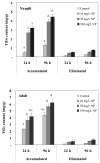Effects of aqueous suspensions of titanium dioxide nanoparticles on Artemia salina: assessment of nanoparticle aggregation, accumulation, and toxicity
- PMID: 22810381
- PMCID: PMC3491177
- DOI: 10.1007/s10661-012-2794-7
Effects of aqueous suspensions of titanium dioxide nanoparticles on Artemia salina: assessment of nanoparticle aggregation, accumulation, and toxicity
Abstract
Aquatic stability and impact of titanium dioxide nanoparticles (TiO2 NPs, 10-30 nm) were investigated using Artemia salina. Acute exposure was conducted on nauplii (larvae) and adults in seawater in a concentration range from 10 to 100 mg/L TiO2 NPs for 24 and 96 h. Rapid aggregation occurred in all suspensions of TiO2 NPs to form micrometer size particles. Yet, both nauplii and adults accumulated the aggregates significantly. Average TiO2 content in nauplii ranged from 0.47 to 3.19 and from 1.29 to 4.43 mg/g in 24 and 96 h, respectively. Accumulation in adults was higher ranging from 2.30 to 4.19 and from 4.38 to 6.20 mg/g in 24 and 96 h, respectively. Phase contrast microscopy images revealed that Artemia were unable to excrete the particles. Thus, the TiO2 aggregates filled inside the guts. No significant mortality or toxicity occurred within 24 h at any dose. Lipid peroxidation levels characterized with malondialdehyde concentrations were not statistically different from those of the controls (p > 0.05). These results suggested that suspensions of the TiO2 NPs were nontoxic to Artemia, most likely due to the formation of benign TiO2 aggregates in water. In contrast, both mortality and lipid peroxidation increased in extended exposure to 96 h. Highest mortality occurred in 100 mg/L TiO2 NP suspensions; 18 % for nauplii and 14 % for adults (LC50 > 100 mg/L). These effects were attributed to the particle loading inside the guts leading to oxidative stress as a result of impaired food uptake for a long period of time.
Figures



References
-
- Adams LK, Lyon DY, Alvarez PJJ. Comparative ecotoxicity of nanoscale TiO2, SiO2, and ZnO water suspensions. Water Research. 2006;40:3527–3532. - PubMed
-
- Arslan Z, Ertas N, Tyson JF, Uden PC, Denoyer ER. Determination of trace elements in marine plankton by inductively coupled plasma mass spectrometry (ICP-MS) Fresenius’ Journal of Analytical Chemistry. 2000;366:273–282. - PubMed
-
- Bahnemann DW, Kholuiskaya SN, Dillert R, Kulak AI, Kokorin AI. Photodestruction of dichloroacetic acid catalyzed by nano-sized TiO2 particles. Applied Catalysis B: Environmental. 2002;36:161–169.
-
- Benn TM, Westerhoff P. Nanoparticle silver released into water from commercially available sock fabrics. Environmental Science & Technology. 2008;42:4133–4139. - PubMed
Publication types
MeSH terms
Substances
Grants and funding
LinkOut - more resources
Full Text Sources
Miscellaneous

